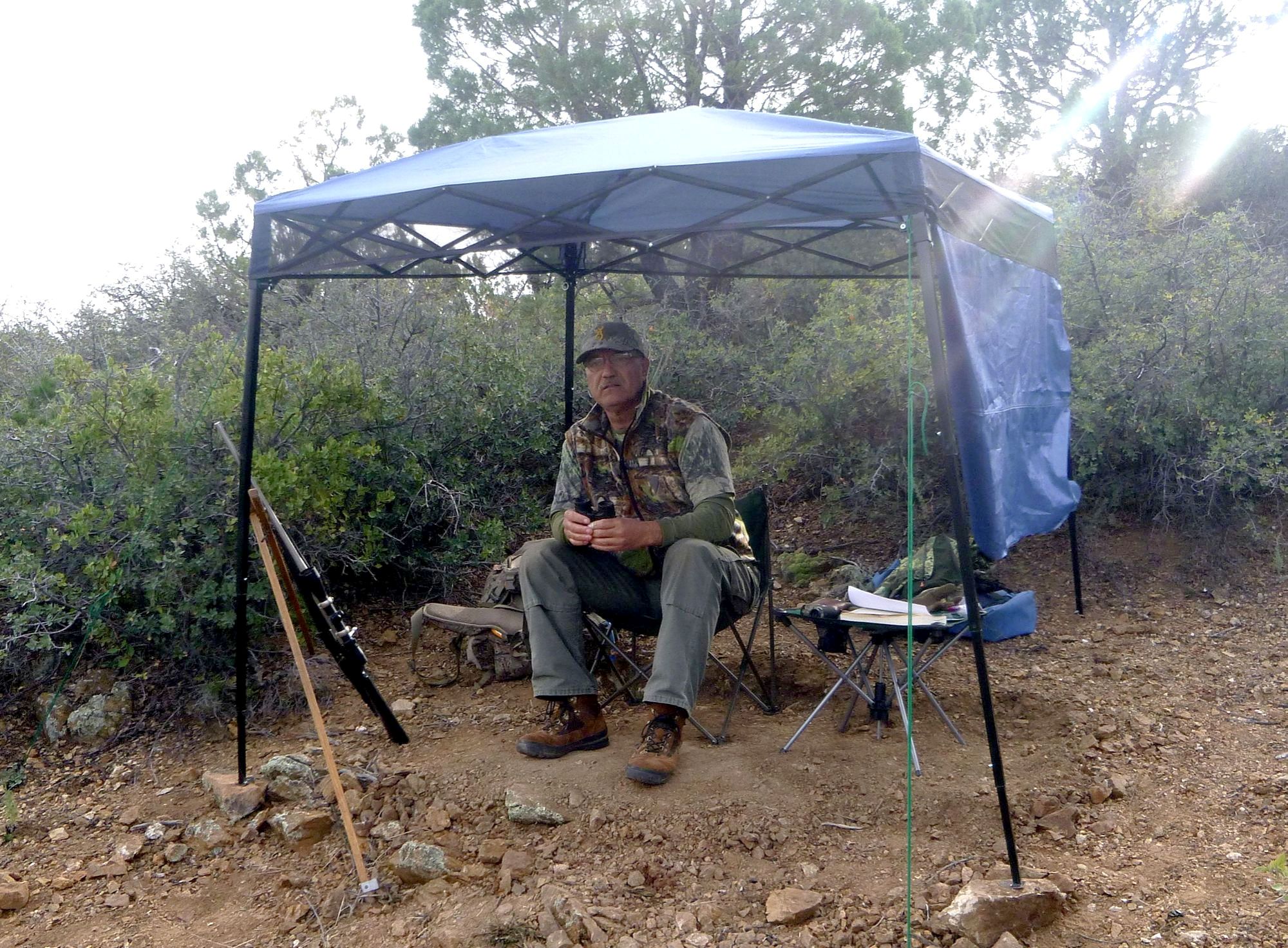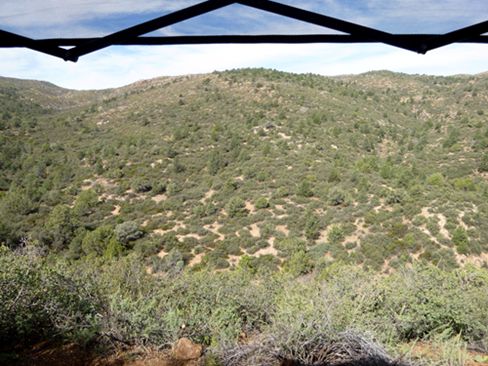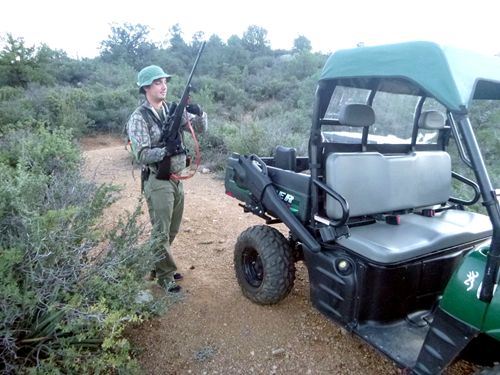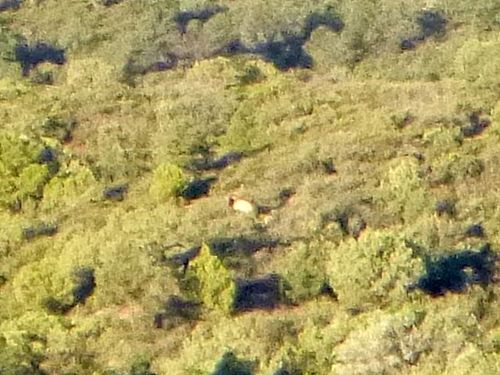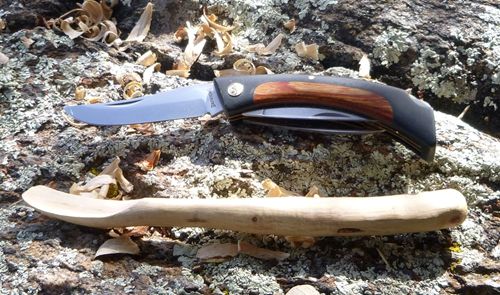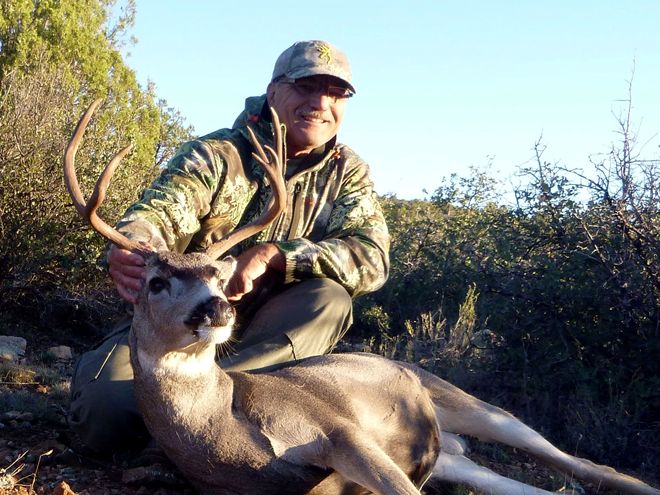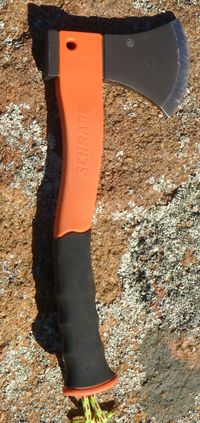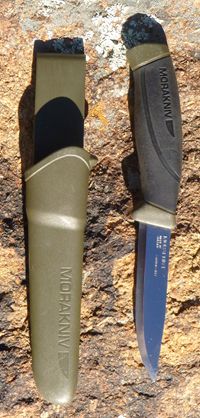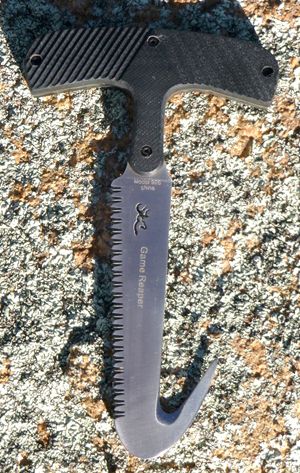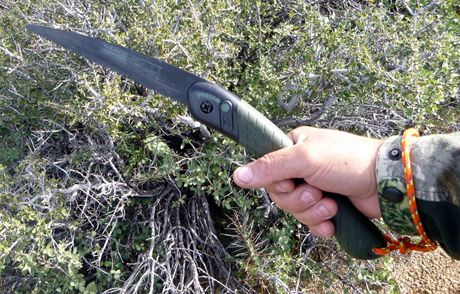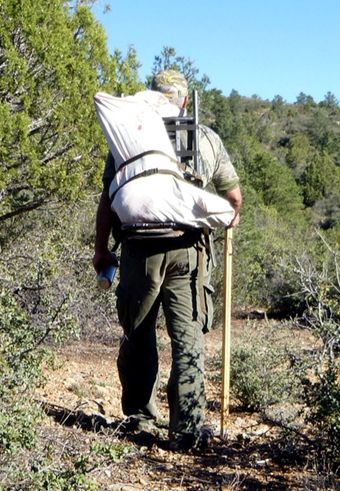
| Articles | Documents | Equipment | Events | Links | Membership | Miscellaneous | Scrapbook | Targets | What's New |
| OP 5400 | December 2015 | ||||||
| Dan Martinez
| |||||||
|
After putting my tag on last year’s very nice 4x4 mule deer buck, you can bet
that the same hunt went onto the deer hunt draw application for 2015. Now that
Ben is back from Oregon and is again residing in Arizona, he went on the
application with me. We were drawn.
Once again, I arranged my vacation time to be able to spend the entire 10-day
season hunting. But Ben is now employed by the Deer Valley school district as
a high school algebra teacher. It was tougher for him to arrange time off.
He would be able to hunt only 2½ days, Saturday, Sunday, and half of Monday,
before he needed to get back to his responsibilities.
I arrived on Thursday morning, the day before opening day. I was grateful to
find that my intended camp spot was clear of campers and available. I had high
expectations that it would be available because the prior two days had seen some
good rains. On arrival I set up our new (to us)
A-frame camping trailer, the “mobile hunting lodge”. Then I left camp to
drive down to my Mom’s house in Chino Valley to pick up the Polaris Ranger. The
Ranger now resides there full time, where Mom uses it to tool around her two acre
property. It gets use there as an agricultural implement to till the land when
the weeds get too high. But come hunting season, the Ranger gets to do what it
was born to do – negotiate rough 4x4 trails and haul game!
When I got back to camp with the Ranger, it was about 2:30 pm. I tossed the
tarp, the blind chair, and the Caldwell FieldPod into the Ranger and drove down
that rock-infested, rutted, narrow, off-camber trail to access the water hole
where I got last year’s buck. I hiked up the slope to my
Sniper’s Lair and set up the waterhole blind. The Sniper’s Lair is near the
top of a ridge that overlooks the water hole from a distance of about 150 yards.
It is south-facing so I set up some overhead cover from the sun to make sitting
in this spot an all-day comfortable affair.
And that’s what I did on opening day. I got seated and situated in the blind
before the sun came up and watched the water hole until the sun went down.
No action.
Ben arrived at camp around 7:00 pm that evening. Since Ben had limited time to
hunt, I offered him the Sniper’s Lair for as long as he wanted. He accepted.
So early Saturday morning, we drove in and parked the Ranger about a one-third
mile hike from the Sniper’s Lair, as I do to avoid motor-vehicle disturbance of
the water hole area. We hiked down to the water hole, then up to the Sniper’s
Lair. Ben had been there once before, last year before the start of the hunt,
but I was sure that he would need to be guided-in to find it a year later.
Our plan was that he would sit the blind and I would spend the morning hiking
up the mountain behind him to see if I could find any luck up there. As
lunchtime approached, neither of us had seen any action. I texted him that I
would meet him around 11:30, and then we would head back to camp for lunch.
But due to the recent rains, I wasn’t so sure that the water hole would be the
best bet this year. The water hole was not the only place to get water right
now. The deeper canyon bottoms had at least a little bit of water holding in
remnant pools. There really was not a good reason for deer to risk the open
exposure of the water hole.
On previous trips I had noticed that the place where I pulled off the rough trail
to park the Ranger had a nice view over the canyon that leads down to the water
hole. The plan was to establish a second observation post on this heavily brushed
north-facing slope. When packing for the hunt, I tossed in a 6’x6’ mini-canopy
thinking that it might come in handy. It’s blue, not camo, but it would do.
So after lunch, with some extra stuff thrown into the back of the Ranger, we
headed back out into the field. After sending Ben off down the trail on foot, I
found an open spot on the slope, downhill a ways from the Ranger. To see down to
the canyon bottom, I had to do quite a bit of bush trimming, even though I located
the canopy and a chair at the top of the open spot. The site afforded a nice view
up the canyon, and some view down the canyon toward the water hole. However, due
to the curve of the canyon, I couldn’t quite see the Sniper’s Lair which was only
about a quarter-mile away. I named the spot OP 5400 for the elevation which was
5,400 feet.
When setting up the OP, I brought along a camp shovel to create a level spot for
the chair. I had to dig in toward the top of the slope, and I used the dug material
to fill below to create a level platform. I also brought along a small canvas
table on which to place a drink, a book, binoculars, rangefinder, and whatever else.
Neither Ben nor I saw any action on Saturday afternoon.
About half an hour later, I spotted a big herd of about a dozen javelina! This is
much more entertaining than watching the shadows change on the vegetation. Ben and
I were in text communication, and he was getting jealous, because there was still
no sign of anything at the waterhole. By the end of the day however, neither of us
had seen any of the deer that we had come out here to find.
Ben would only hunt the one more half-day, Monday morning. Same plan: Ben at the
waterhole, me at OP 5400.
Settled in at the OP as the sun rose over the eastern ridge, the first rays of
light began to illuminate the slopes of the surrounding hills. As I looked far
up-canyon, I noticed a large light-colored animal grazing on a ridge. Yes, there
are cattle in the area. Today I happened to bring along my large 12x50mm porro
prism binoculars. Since I knew I wouldn’t be hiking, and that I would be just a
few steps from the Ranger, they were no burden to bring along to the OP.
This unit is lumped together with several other units for a “Limited Opportunity”
elk hunt. That means that though elk tags are issued, you can expect to go the
whole hunt and not see even any sign of elk, let alone the buff-colored fur of one.
They are very thinly distributed in these limited opportunity hunt units. Yet here
before my eyes was one of the largest bulls I had ever seen. He was alone. As I
watched him at 12x for nearly half an hour, I saw his antlers from the side, from
the front, and from the back. They reached very high, very wide, and very far back.
It was an incredible show. At one point I hit him with the laser rangefinder –
706 yards.
I had along a small pocket camera. I dialed it up to max zoom and attempted to get
his picture. The photo above was the best one that I got. It’s not great, but I
think that you can get a sense of how big this bad-boy was!
Eventually the bull wandered out of sight, and later the lunch hour arrived. Ben
met me at the Ranger and we headed back to camp for lunch. We ate our lunch, Ben
packed up his stuff, but he hung around until I was ready to head back out, at which
point Ben left to go back home.
While sitting in the OP that afternoon, I became curious to know exactly where was
that bull? I remembered a little-used function on the GPS called Sight ‘N Go. This
function allows you to place a GPS waypoint somewhere besides where you currently
stand. I knew the accurate distance from the OP to where the elk stood since I had
hit him with the range finder.
So I fiddled around with the GPS until I found Sight ‘N Go. Sight ‘N Go depends on
the GPS having a built-in compass. The first thing you do is point the GPS at the
position where you would like a waypoint. When you are ready, you hit a button to
lock in the bearing to the position. Then it asks you to input the distance. This
you can do in various units of measure including yards. So I typed in 706 yards and
it gave me a waypoint. By checking the topo on the GPS, I discovered that the elk
was just a quarter mile hike from the rough trail that we come in on, but about .4
miles back from where we always park.
So the first thing the next morning, I tried to get to the elk’s position. Using
the GPS, I was able to get to within 200-something yards. I ended up on a steep
heavily-brushed hillside above the elk’s ridge. I could have shot him from here.
But I had no appetite to go down this steep hillside, cross a canyon pushing through
thick brush, just to get to the elk’s ridge. It was neat to know where he was and
that I could have got to him using this GPS technique.
After this, my plan was to hang out in the Sniper’s Lair for the rest of the day.
I had some leftover MRE food that I assembled into an MRE lunch. It included Cheese
Tortellini in Meat Sauce, Mexican-Style Rice, and a pack of Nutter-Butter cookies.
As I hiked down the trail after parking the Ranger, it hit me that I forgot to pack
a spoon! A full unopened MRE always includes a spoon to dig the food out of those
packets.
After carving out the basic shape, I was able to get it quite smooth by using a
scraping technique with the blade held perpendicular to the surface. For final
smoothing, I picked up a rock off the ground and used it as a sanding block.
Before lunch, I concentrated on getting the bowl functional for eating. After
lunch I continued to refine the spoon some more, slimming up the handle and better
defining the underside of the bowl.
Did any deer come to water while I was sitting and carving? Who knows? Yes I
probably spent too much time concentrating on making the spoon, and not enough
time watching the water hole!
I have nothing of interest to mention for Wednesday. For Thursday, the National
Weather Service had been reporting that a significant rain event was coming in.
I always keep track of the weather in camp with an emergency radio. I decided
to take a day off from the hunt for Thursday. I slept in and relaxed in the
camping trailer all day. I worked on the club newsletter and did some reading.
The rain did indeed come down for most of the day, but I was as snug as a bug
inside the mobile hunting cabin, and thankful for it.
I was still in “lazy mode” when Friday morning dawned. I let the day become
illuminated before I woke up. Then I looked out the window and saw all the trees
blowing around. Though the skies were now mostly clear, the exiting weather
system would make Friday a cold and windy day. I was in no hurry to get out
there in the cold wind.
“Alright, alright”, I finally said to myself. I dragged myself out of the warm sleeping
bag, gathered up my gear and hopped into the Ranger to head to the OP.
As I sat there with the wind blowing, I noticed that the flapping canopy cover
was making quite a bit of noise. And since the day was cold, I figured that
the sun shining on me would not be such a bad thing today. I took the cover
off the accordion frame and stuffed it under a nearby bush.
Not long after that, I saw my first deer of the hunt. He was up-canyon and
across, about 350 yards away. I could see that he wasn’t as big as last year’s
buck, but there was enough bone sticking up in the air to make him a shooter.
I never got the itch to raise the rifle on him though.
With the heavy wind and the extended distance, it just seemed to be a shot too
risky to take. For a rifle rest, all I had at the OP was shooting sticks.
Those aren’t quite as stable as the Caldwell FieldPod. There was no way to get
steady prone, due to all the bushes.
The distances straight across the canyon from me were from about 130 to 300
yards, and of course even farther. I felt fairly confident with shots out to
300 off the sticks, in a no- to low-wind situation. But here we had heavy wind,
and the deer was up-canyon from me at a distance of 350.
I continued to watch him through binos, but in less than 5 minutes, he walked
out of sight. After he was gone, I began to second-guess myself. “Dan, you’ve
got lots of experience making shots of that distance in club matches.”
Today I had in-hand my Browning Stainless Stalker A-Bolt in .260 Remington.
This is one of my favorite rifles. I shoot it well and have utmost confidence
in my ability to hit with it. The load I was hunting with was the Sierra 120
grain ProHunter at around 2800 fps. With this rifle and load, earlier this
year I had bested the field in both the CF Rifle Silhouette Match and the
Buckhunter’s Challenge. I knew that the rifle was sighted in nuts-on with
this load. In addition, the rifle is equipped with a ballistic reticle scope
that I took advantage of to make long range hits at the Silhouette match. But
all of that was with low wind. It was today’s stiff wind that made me lose my
confidence in the shot presented. So if this were the Buckhunter’s Challenge,
I took a zero by declining the shot.
With the lost opportunity gnawing on me, I decided to try to get closer to
where I last saw him by walking up canyon on my slope. I probably got about
100 yards farther up-canyon before being stopped by impenetrable brush and a
side canyon. I returned to the chair at the OP.
As lunch rolled around I pulled another (full, unopened) MRE out of my pack
and chowed down. With my mid-day hunger satisfied, I decided to hop in the
Ranger and head up the quad trail to get to that other up-canyon lookout point
that I could not reach by foot from the OP. The trail goes around the head of
the side-canyon that stopped me earlier.
As usual, I had to fight through a maze of scrub oak, juniper and manzanita
to reach the edge of the ridge that overlooked the canyon. I now had the OP
about 200 yards to my right (east), and the elk position about 500 yards to
the left (west). But now I was probably only about 200 yards from where the
deer stood earlier today across the canyon to the north. Looking into some
fresh slopes, this was a great new vantage point for me. I took a seat on
the ground at the top of an open spot to sit and observe for the rest of the
afternoon.
As the afternoon wore on and the sun was about to dip below the western ridge,
I had not seen that buck again. I decided to go back to the OP to take down
the naked canopy frame, and pack it up. At this point there were only two
days left in the hunt, Saturday and Sunday. I might as well start putting
things away.
As I fought my way through the maze to get back to the Ranger, I decided to
dial the scope down to 3-power. There was a chance that I could jump a buck
at close range as I worked my way through the jungle. I found the Ranger,
stowed the rifle in the ATV scabbard, and drove back down to the OP.
After parking, as I walked down the slope to get to the OP, I slowed and looked
across the canyon just in case there might happen to be a buck over there. Nope,
saw nothing. I stood the rifle in a bush off to the side of the clearing because
I didn’t want to knock it with the canopy frame as I wrestled it into submission.
First I pulled the stakes that had held the canopy down for these several days.
Then I removed and stowed the guy lines. Then it was click-push-click-push to get
it collapsed to fit in its backpack sized bag. I folded the canopy top and stuffed
it in the bag too. I got it all zipped up and noticed that I probably still had
about 15 minutes of light left in the day. I decided to plop my butt down in the
chair, relax, and watch the day come to a close.
As I looked up canyon, I noticed the rifle out of the corner of my eye in the bush
about three steps away. As I turned my head to scan down-canyon, I thought to myself
that I need to grab that gun and put it on the canvas table beside me so that it’s
in-reach. Then I saw the buck.
When I first noticed him, he was looking the other way. But as my eyes locked on and
focused on him, he turned to look directly at me. I don’t know what animal-magic
allows them to sense that they have been seen by a human.
Since I was sitting in the chair, I did not present a human silhouette to him. Plus
the bushes in front of me probably hid everything from him except for my upper chest
and head. I raised my butt just barely off the chair and crab-walked three steps to
the left to reach the rifle. Then I crab-walked back and dropped my butt back into
the chair.
There was a lot going on inside my head, but none of it took any time away from the
process of putting the cross hairs on him and pulling the trigger very quickly. I
ranged him by eyeball at about 200 yards. I sized up his rack and came to the
conclusion that he was smaller than last year’s buck, but he was good enough to shoot.
It was very likely that this was the same buck that I saw this morning. He was
looking at me the whole time that this was going on, not understanding that he was
about to be shot.
CRACK!! As soon as the crosshairs found the front half of his body, the rifle went
off. He started moving away, but in a limping fashion. Work the bolt - swing into
him as he moved – CRACK!! He’s down! As I often do at times like this, I talked to
myself. “Now you’re in trouble, Dan.”
Due to the steepness of the slope down to the canyon bottom and the thick growth all
over it, it wouldn’t be easy to go straight to him. The best way to get to him was
to hop into the Ranger and drive down to the water hole, then hike back up-canyon to
find him. Time was not on my side.
Using my guess of 200 yards, I tried to use the GPS to tell me when I was 200 yards
from the OP. I searched and searched until it got dark but I could not find him.
I tried to picture what I saw at the moment I fired when I was on the ground searching,
but it didn’t help. Darkness came so I reached into my pack and donned a head lamp.
I continued searching hoping that the beam would illuminate his eyes to help me find
him. I searched for about another 20 minutes in the dark with no luck. I made the
decision to abandon the search and come back in the morning ...
| |||||||
| If you enjoyed this story, or found it useful, please consider clicking here to join the NRA at a discount of $15 off the normal membership cost. You will be supporting both this website and adding your voice in support of the Second Amendment. Thank you very much. |
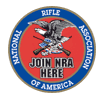
|
| Bladeology: Game Processing | December 2015 | ||||||
| Dan Martinez
| |||||||
|
The decision to abandon the search and come look again in the morning came rather easily.
With the cold day, and a clear night ahead of me, I had confidence that the deer would
keep well overnight.
I knew that I would have to pack him out on my back – not far, but the extra processing
steps of taking him apart into pieces small enough to pack would be so much easier with
daylight.
Besides, I had left the pack frame behind at camp. Earlier in the hunt I had been
carrying it around in the bed of the Ranger, but when the rainy day came, I put it into
the enclosed bed of the Avalanche to protect it from the rain.
As for finding him, I now had a new trick up my sleeve, Sight ’N Go. I intended to
first stop at the OP, identify by sight where he stood when I fired, and fix a waypoint
using the rangefinder and Sight ‘N Go on the GPS. That should allow me to go directly
to him, just as if I was hiking in to a geocache.
After dinner at camp, I spent some time rehearsing in my mind the steps I would need to
take to make the recovery – therefore, what equipment I would need. As I created this
mental checklist, I packed those items into the hunting pack or into the bed of the Ranger.
I had quite a number of bladed instruments with me on this trip. I brought them along
to take photos of the various tools for future Bladeology write-ups. But for this
installment, I want to concentrate on the four you see pictured on the right. These
are the four that my mental rehearsal told me would be the most useful for this deer
recovery operation.
Besides the blades, I tossed into my pack four elk-quarter game bags and a small plastic
tarp. The purpose of the tarp was to be a clean place for placing pieces of meat.
At first light when I got to the OP, what I now saw in front of me did not match up
with the picture that my mind had recorded in those critical moments. After a while
I decided that over THERE had to be the place. I shot the opposite slope with the
laser range finder – 185 yards. I pointed the GPS at the spot and locked in a
waypoint. Now to drive down to the water hole.
I hiked up the canyon and reached the projected waypoint. Of course I was not
expecting the buck to be exactly there. I started circling the zero and quickly
came upon the buck only 112 feet away from the waypoint! Hey, this works! I didn’t
find him the night before because I was searching too close to the canyon bottom.
He turned out to be higher up the cross-canyon slope than I had thought.
Now I could take a waypoint of his actual location. Overnight I came to the
realization that I had never taken the scope off 3-power before making the shots.
I had made those two quick-reaction, cross-canyon killing shots, the first one at
185 yards, the second at 195, at 3-power, with no rest.
His rack turned out to be 3x4. There are three points on his right side, and on
his left side, the forward branch has a small “crab-claw” fork to give him 4 points
on that side.
Moments after pulling the buck out of the bushes and into an open spot, the sun
peeked over the eastern ridge. The light was perfect to take one of the best
hunter-with-game photos that I’ve ever taken. But now it was time to get down
to business.
Before my recent blade fetish, I had done nearly all of my field care of game
with one tool, the Browning Big Game folder pictured with the wooden spoon a
couple pages back. It has three blades: a knife blade; a gut hook blade, and a
small saw. Basically, that’s everything you need.
However, I began to realize that it is a compromise tool when Sam and I had to
quarter his cow elk back in the fall of 2010. We each had one of these knives,
and we did get the job done. The difficulty came when we had to do the saw work.
The saw on these folders is only 2¾” long.
There’s a hell of a lot of bone-sawing work involved in quartering an elk. And
they are big bones. The saw work with only a 2¾” stroke became very tiring. Ever
since then, I have carried a larger saw in my hunting pack. The Browning Big Game
folder is still plenty to do the job on javelina, Coues whitetail, and mule deer
too, as long as cutting it up into pieces isn’t required. But since I had choices
for this job, I decided to use more optimum tools. I left the Browning folder
unbloodied this time around.
Horace Kephart, The Book of Camping and Woodcraft, 1906
This was one of the books I was reading during the rainy day layover. Old Horace
suggested that I might find the hatchet useful for splitting the ribcage. By golly,
when I tried it, I was amazed. It only took three light chops up the sternum, and the
ribcage was split. This allowed easy access for removal of heart, lungs, diaphragm,
and windpipe. Usually, I don’t split the ribcage. I just reach up and in from below.
I had tried splitting by sawing before, and it took a lot of sawing. Horace was right.
When working the deer on the ground I did a little bit of skinning then a little bit
of organ freeing. Then I went back and did a little more skinning, then back to organ
removal. I wasn’t sure whether I was quartering or halving the deer until rather late
in the process. Eventually I decided that halving would be the best.
I used the Mora on both deer and elk last year and came away quite impressed. Last
year I didn’t use it exclusively, I used the Browning Big Game folder as primary. On
the elk, I used the Mora for most of the meat-slicing quartering work. On the deer, I
used it mainly for the skinning work. This is the first time that I decided to keep
the Browning knife clean and use the Mora as the primary blade.
This Mora is the carbon steel version, not stainless steel. As a result, the blade
will tarnish with use. Carbon steel is supposed to take a better edge however. I
found that Flitz metal polishing paste does an excellent job of restoring the factory
fresh shine to the blade. Then just give it a rubdown with an oil to protect the finish.
If that’s too much hassle, then get the stainless steel version.
One of the big problems I have had with the Browning Big Game folder is all the junk that
gets into the nooks, crannies, and the folding mechanism of the knife when it is used to
field dress an animal. Cleanup takes soaking it in a pot of hot water, then using a brush
to get all that junk out of the knife. The Browning Game Reaper, like the Mora, is a
simple one-piece tool that cleans up much easier.
The Game Reaper is inexpensive, about $18 most places, yet is made of high quality 440-C
stainless steel with G10 composite handles. Construction is full tang, as the blade metal
extends entirely through the T-handle. It comes with a ballistic nylon belt sheath, though
I can’t imagine why you would want to carry this around on your belt every day. Just
sheath it and keep it in your pack until needed.
The term “guthook” is a bit of a misnomer, but not entirely. The main purpose of the hook
is to efficiently split the hide. Starting with your knife, you pull up a pinch of hide at
the belly. Make a small incision, just through the skin. Insert the point of the hook into
this incision, then rock the point upward so that it does not snag the underlying paunch.
Then pull the hook towards the neck, then come back and repeat the procedure toward the
genitals. Now you have a nice split in the skin from front to back. From here, you work
with your knife to peel back the skin, getting it out of the way for next steps.
The hook can also be used for splitting the skin along the underside of the legs, to aid
skinning. Yes, once you have peeled the skin away from the paunch, you can now use the
guthook to split open the paunch as well, spilling the “guts”.
The point of the hook on the Game Reaper is longer than the hook on my Browning folder.
I found it a bit easier to use than the one on the folder. The short one can sometimes
jump out of the slit as you pull.
The saw portion of the Game Reaper is not much longer than the one on the Browning folder
at 3⅛”. So it is not a substitute for a bigger saw for elk quartering tasks. There is a
legitimate need for a short saw though. That is for the delicate work of splitting the
pelvic bone in the vicinity of organs that you do not want to accidentally open to spill
their contents on the meat. I did use the Game Reaper’s saw for this purpose on this deer.
One weakness of the Game Reaper’s saw, and the one on the Browning Big Game folder as well,
is that the teeth have no offset to create a kerf, or saw groove, that is wider than the
blade. This can lead to the blade binding in the groove on deeper cuts. This just
reinforces the need for a real saw in your woods rambling kit.
I kept it tucked into the side mesh pocket of my hunting pack and used it extensively
on this trip, just about every day for brush clearing duties. It is extremely efficient
in cutting the woody branches of scrub oak and pine. Since it is a real saw, the teeth
are offset to make the cut wider than the blade to prevent binding. For cutting smaller
branches, grab the top of the branch with your weak hand, and usually just one draw
stroke of the Bahco in the strong hand will take off the offending branch.
I even used it once to cut off an 8 inch diameter pine stump for use as a chopping anvil
at the campfire. Sure, that took some time and effort as I made my way around the stump
making the cut. But the end result was an extremely clean and flat cut.
As great as it is as a wood saw, I had my wonders about how good it would work as a bone
saw. You generally want smaller teeth on a bone saw than you want on a wood saw. I need
not have feared.
After fully skinning the hind quarters, I sliced between the second and third rear-most
ribs all the way to the backbone on each side. From the top, I sliced the backstraps to
the backbone. Now I just had to sever the backbone itself to separate the rear half of
the deer from the front half. The Laplander got the call of duty for this job – no problem.
I also found that the Laplander did an excellent job of cutting off the deer’s hocks.
That was much easier than past efforts using the short pocket knife saw.
There are a lot of choices out on the market for taking care of the various tasks that
need to be done to process game in the field. It can be done with a single multi-purpose
tool such as the Browning Big Game folder; or there are packaged kits available from some
manufacturers loaded with a number of different tools. For now, I have moved to a mix
and match approach which allows me to pick exactly what I think are the best tools for my
needs in the field.
| |||||||
| If you enjoyed this story, or found it useful, please consider clicking here to join the NRA at a discount of $15 off the normal membership cost. You will be supporting both this website and adding your voice in support of the Second Amendment. Thank you very much. |

|

|
|
